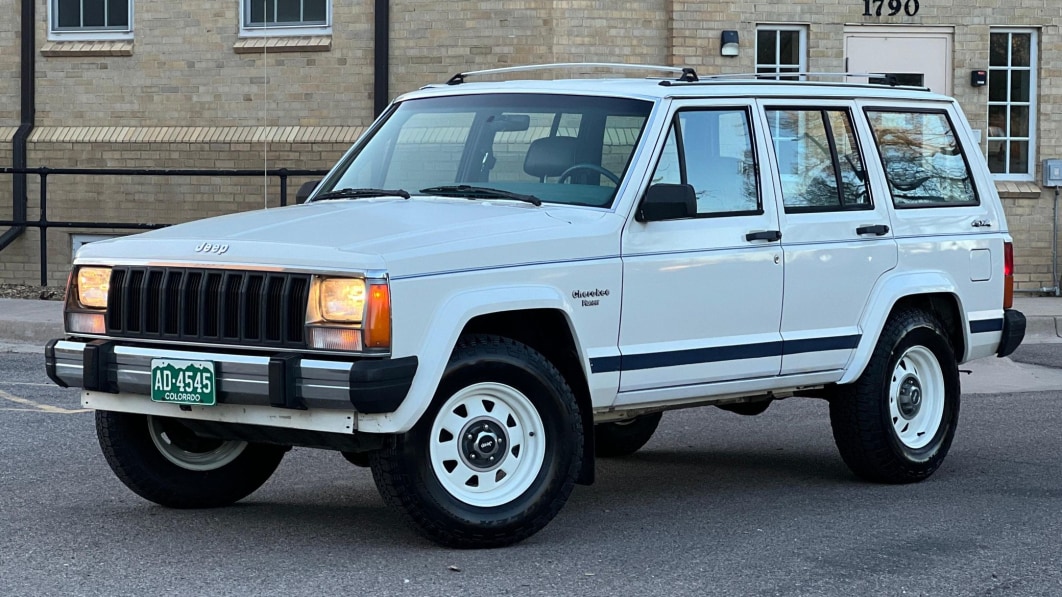We have the original Jeep Cherokee to thank (or blame) for the crossover’s rise. Released for 1984, and called XJ internally, the model gained a loyal following by bridging the gap between family-friendly station wagons and burly body-on-frame SUVs. Many early XJs were driven into the ground, heavily modified, or chewed alive by rust, but a clean-looking example with cool options has popped up on Cars & Bids.
Jeep may have drawn inspiration from existing four-wheel-drive cars when it started developing the XJ. Subaru had offered wagons with four-wheel-drive for years, and American Motors Corporation (AMC), which Jeep was part of, had managed to carve out a niche for the four-wheel-drive Eagle wagon. Regardless, the idea was to downsize the Wagoneer-derived Cherokee into a more daily-drivable vehicle without losing off-road capability. The brand notably shifted away from body-on-frame construction and created a new architecture called Uniframe.
By downsized, we mean downsized. The original, Wagoneer-based Cherokee measured 183.5 inches long, 75.6 inches wide, and 65.9 inches tall, and it weighed 3,764 pounds. The XJ Cherokee posted numbers of about 165, 70, and 63, respectively, and it tipped the scale at approximately 2,900 pounds. It was available with two or four doors (most of its rivals were two-door-only), which made it well-suited to family-hauling duties. Jeep’s paid bet off: The XJ-generation Cherokee nearly doubled the brand’s sales about a year after it went on sale.
The example listed on Cars & Bids is the Pioneer model, which was positioned a notch above the base trim in 1986. It’s finished in Olympic White with a blue cloth interior, it’s riding on body-colored 15-inch steel wheels, and it was ordered with swing-away spare tire carrier that Jeep offered as an option on early models. It’s nearly unmodified and it appears to be in fairly good shape for an off-roader that’s quickly approaching its 40th birthday. Effortlessly rugged, it perfectly illustrates what the term “SUV” meant to many drivers in the middle of the 1980s, and it will certainly strike your nostalgia chord if you spent any amount of time in the nation’s mountainous regions in the 1990s.
Jeep buyers had three engine options to choose from in 1986. The base engine was a 2.5-liter four-cylinder rated at 117 horsepower and 135 pound-feet of torque. From there, customers could take the XJ in two wildly different directions. One option was a 2.1-liter turbodiesel four-cylinder borrowed from Renault (remember: AMC was under French control for years) and tuned to develop 85 horsepower and 132 pound-feet of torque. Alternatively, a General Motors-sourced 2.8-liter V6 rated at 115 horsepower and 150 pound-feet of torque was offered.
(Yes, the four-cylinder made more horsepower than the six. This was the 1980s; ’nuff said).
The 1986 example on Cars & Bids is powered by the six-cylinder, which is widely considered to be the more desirable of the three options. The output reaches the rear or the four wheels through a five-speed manual transmission and a two-speed transfer case. Here again, this is how you’d want to configure one of these. The other transmission options for 1986 were a four-speed stick and a three-speed automatic.
Jeep made numerous changes to the XJ-generation Cherokee during a production run that ended in 2001. The famous 4.0-liter straight-six replaced the 2.8-liter V6 for 1987, and the 1997 model year brought a new look that the Cherokee wore until it retired — in the United States, at least. Production continued in China into the 2010s. While the XJ was showing its age in the latter years of its American life, it remained a reasonably popular entry into a segment it helped create, and the nameplate was part of Jeep’s portfolio through the 2023 model year.
Bidding on the 1986 currently stands at $1,155 with six days left in a seven-day auction, so there’s plenty of time for that figure to rise. And, this is a no-reserve auction so the highest bidder will take home a cool and relatively early example of one of Jeep’s most influential models.

